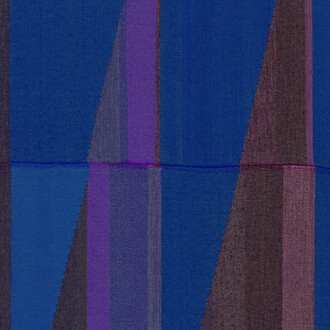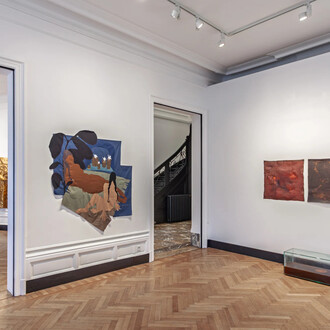Almine Rech Gallery is pleased to announce Belgian artist Johan Creten’s second solo exhibition with the gallery. The title ‘8 Gods’ stems from his new series of sculptures, created specifically for this exhibition. ‘8 Gods’ is shown simultaneously with one of Creten’s most important monographic exhibitions to date, ‘La Traversée / The Crossing’, currently running at Crac Occitanie / Pyrénées-Méditerranée in Sète, France, until April 17th, 2017.
Since the 1980s, Johan Creten has proven to be a true trailblazer in the resurgence of ceramics and the use of traditional techniques in the contemporary art world. This is demonstrated by the series of wall works entitled Wargames, exhibited in the first gallery room, which allow the viewer an opening glimpse of Creten’s artistic universe. Straddling the border between painting and sculpture, Wargames first began in 2013 following his Alfred Paintings executed during a residency at Alfred University, New York State. Wargames bring together melted glass and elements in sculpted clay, which once fired and glazed take on the radiant golden texture of a bee’s nest. While bringing to mind the bee’s meticulous method of honeycomb construction, the geometrical constellations covering each sculpture resemble mental landscapes, geopolitical maps or video game battle plans. From afar the pieces can be taken for intimate paintings; it is precisely this hybrid and lively character that reminds us of Creten’s interest for plays on perception. The sheer beauty of the seductive, shiny and translucent enamels contrasts with their solidity, opacity and handmade appearance. Enamel work is dear to the artist for its intrinsic symbolic values, reflecting a creative act of resistance at odds with abstraction, in the face of a world in constant change. This impulse towards commitment and to what Creten describes as “making tenacious (weerbarstig) works” evokes the themes of both personal and collective destiny already present in pieces such as Naissance d’une Ombre (1993) and Pliny’s Sorrow (2011).
A group of more architectural and figurative works is installed in the main room. Three imposing black columns, entitled Massu, cast in bronze, punctuate the space. Both stable and dynamic, these pillars shoot upwards in a burst of vital energy. The largest of the three stands at almost six meters high and seems to pierce the gallery’s ceiling. Creten took to working with bronze about ten years ago, seeing the material’s potential for sculptural experimentation. The continuity and regularity of these works cause them to enter into dialogue with Brancusi’s ‘Endless Columns’, revealing a shared gestural radicalness and a desire for immemorial elevation present in both artists’ practices. However, gathered together as a trinity, Creten’s columns differ from Brancusi’s primitivist vision by virtue of their emotional gravity. Different versions and editions of the sculptures have been shown at the Middelheimmuseum in Antwerp, Belgium (2014), the Gellone Abbey in Saint-Guilhem-le-Désert, France (2015) and are part of the permanent collection of the NOMA (The Sydney and Walda Besthoff Sculpture Garden, New Orleans Museum of Art) in the United States.
Among these monumental architectural elements will be placed 8 Gods, new figurative sculptures on coloured pedestals in glazed ceramics. Completed over the past two years at atelier Struktuur 68 in The Hague, these masculine and feminine characters come together in a lively yet silent council; partially or totally veiled, their postures recall antique sculptures or sacred figures. Each sculpture’s uniqueness is reinforced by the enamel firing technique, animating the works, which seem to converse between themselves and with the viewer. The latter is also invited to take a seat on one of the coloured ‘Points d’Observation (Viewpoints)’ in order to view the exhibition and interact with the surrounding muses. Creten specifically conceived of these works — whose shape echoes that of a mooring post — as a breath or pause between the other pieces. These ‘Points d’Observation (Viewpoints)’ urge us to take our time. This series also allows Creten to pursue his reflections upon the relationship between sculpture and pedestal, between the spectator and his environment of images. With the exception of The Boy, when reading the allegorical titles of the other works we discover a series of dualities and opposites: The Knife shies away from us, suggesting an archetypal figure of seduction, yet is she not also the victim who becomes the abuser? The quintessential tragedian; think Maria Callas in the spotlight. Like ghosts, The Ring and The Mirror evoke prudence and justice in equal measure to doubt and resistance. The Veil, with its face entirely covered, is perhaps even the allegory of this hidden system, indecipherable at first glance.
‘8 Gods’ opens like a theatrical staging or a contemporary temple wherein Creten’s Wargames at the exhibition entrance symbolize a sculpted peristyle. The ensemble of columns and statues gathered here by the artist meld individual memory and historical narratives in a syncretic and poetic sculptural universe, inviting the viewer to partake in a contemplative perambulation.
Life is neither good nor bad
Life is life and all we know
Good and bad and joy and woe
are woven fine(Leonard Bernstein, Candide, 1956)
















